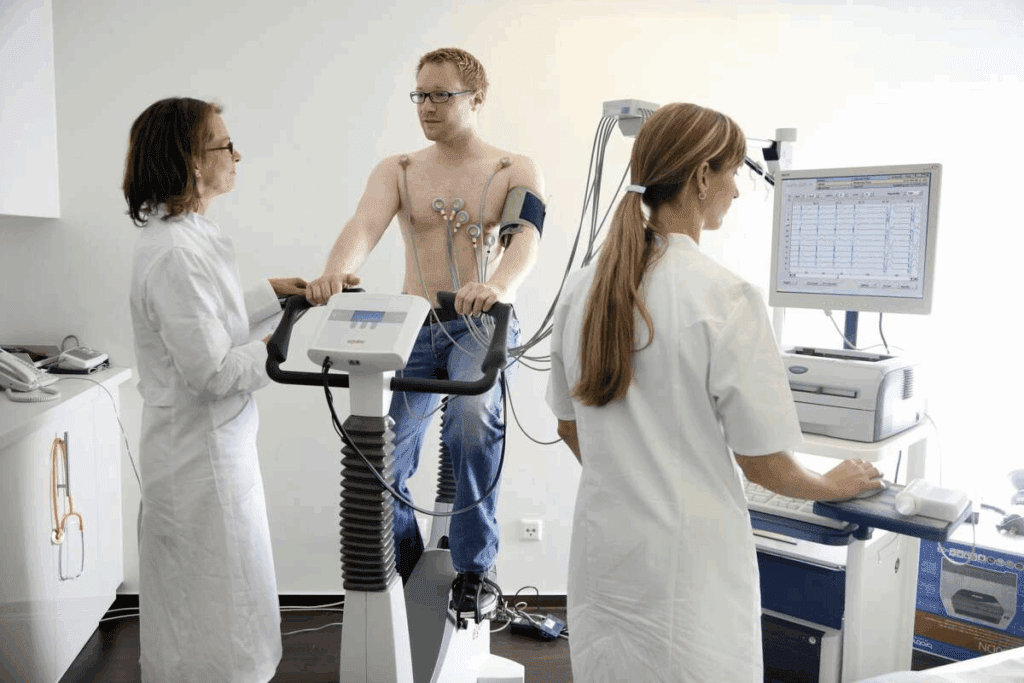Last Updated on November 25, 2025 by Ugurkan Demir

At Liv Hospital, we use a treadmill stress test, also known as an exercise stress test. It checks how the heart reacts to more physical activity. This tool helps us see how the heart works when it’s stressed, usually by exercise.
Discover what is a treadmill stress test, its purpose, and how it helps monitor your heart during exercise.
We watch heart rate, blood pressure, and ECG readings closely. This gives us important information about the heart’s health. It’s key for checking heart health and finding heart problems.

A treadmill stress test, also known as an exercise stress test, is a non-invasive way to check the heart’s health. It shows how well the heart works when we exercise. Our body needs more oxygen when we move, and the heart must pump more blood to meet this need.
This test is key for checking heart health and finding heart problems.
An exercise stress test checks the heart’s function when we’re physically stressed. We watch the heart’s activity as the patient walks on a treadmill that gets harder. This lets us see how the heart handles stress and find any heart issues.
The idea behind stress testing is to see how the heart acts under stress, usually from exercise. It helps find heart disease, see how well someone can exercise, and figure out why they might have chest pain or trouble breathing.
Treadmill stress tests are also called stress test, exercise test, and cardio stress test. Even though they have different names, they all aim to check the heart’s performance under stress. There are various stress tests, but the treadmill test is one of the most common.
Knowing the different names and types of stress tests helps us understand their importance in heart care. By recognizing these, we can better diagnose and manage heart conditions. This leads to better health outcomes for patients.

We use treadmill stress tests to see how the heart works under stress. This test is non-invasive and helps check heart health during exercise.
Treadmill stress tests show how the heart reacts to physical stress. When you exercise, your heart beats faster and blood pressure goes up. This test checks if your heart can handle this.
The science of stress testing includes several important parts:
Treadmill stress tests are different from other heart tests. Unlike resting ECGs, they check heart function under stress. This gives a better look at heart health.
Some main differences are:
Understanding stress testing and its differences from other heart tests shows why treadmill stress tests are important. They help diagnose and manage heart health.
The main goals of a treadmill stress test, also known as an exercise stress test, are to check heart function under stress. It helps diagnose heart conditions and evaluate cardiovascular health. We use it to see how the heart reacts to physical activity.
A cardio exercise stress test is key in diagnosing coronary artery disease. This disease damages the heart’s blood vessels. We watch the heart’s performance under stress to spot any blockages or blood flow issues.
The test checks if the heart muscle gets enough oxygen-rich blood when active. If the coronary arteries are damaged, the test can show signs of reduced blood flow. This might mean coronary artery disease.
A stress exercise test also checks an individual’s exercise capacity. It looks at how well the heart works during exercise and the person’s fitness level. The test tracks heart rate, blood pressure, and oxygen use to measure fitness.
A stress test for heart health is also for checking heart symptoms. Symptoms like chest pain, shortness of breath, or palpitations are monitored. This helps find the cause of these symptoms and plan treatment.
“Stress testing is a valuable diagnostic tool that helps us understand how the heart responds to physical stress and identify possible issues before they get worse.”
Understanding treadmill stress testing’s main goals shows its importance in heart health. It helps diagnose diseases, check fitness, and look into heart symptoms. This test is essential in cardiac care.
A treadmill stress test checks your heart health by watching how it works during exercise. We’ll show you what happens from start to finish, including before and after the test.
Your doctor will ask about your health and how often you exercise before the test. This helps decide how hard the test will be. You might be told to:
Remember, the test involves walking on a treadmill. Your heart rate, blood pressure, and ECG will be watched closely.
During the test, you’ll walk on a treadmill that gets faster and steeper. It keeps going until your heart rate hits a certain level or you feel symptoms like chest pain. Our team will keep an eye on:
After the test, you’ll be watched for a bit as your heart rate and blood pressure go back to normal. This is important to see how your heart recovers. Our team will keep checking your ECG and watch for any bad reactions.
| Stage | Key Activities | Monitoring Parameters |
| Before Test | Medical history review, preparation advice | N/A |
| During Test | Walking on treadmill, increasing intensity | Heart rate, blood pressure, ECG |
| After Test | Recovery monitoring | Heart rate, blood pressure, ECG |
Doctors watch several important signs during an exercise stress test. They check how the heart works when you’re active. This helps them see if the heart is healthy.
They look at how your heart rate and blood pressure change. Heart rate should go up when you exercise. They check if this increase is normal. They also watch your blood pressure to make sure it stays healthy. If it doesn’t, it could mean there’s a heart problem.
The electrocardiogram (ECG) is also very important. It shows the heart’s electrical activity. Doctors look for signs of heart problems in the ECG. This helps them find out if you have heart disease or other heart issues.
Doctors also watch for physical symptoms during the test. Things like chest pain or feeling dizzy are important signs. They see how these symptoms relate to the exercise and other signs they’re watching.
By looking at all these things, doctors can really understand your heart health. They can then decide what tests or treatments you might need.
Understanding treadmill stress test results is key for doctors to care for their patients well. This test shows how the heart works when stressed. It helps find problems and plan treatments.
A normal test means the heart works fine under stress. But, an abnormal result might show heart disease or other issues. Even if it’s not serious, it means we need to check further.
We look at heart rate, blood pressure, and ECG during the test. Any unusual signs could mean heart trouble. For example, ST-segment depression on an ECG can show heart muscle problems and needs more tests.
What a test result means can be different. A normal result is good, showing a healthy heart. But, we also look at the patient’s overall health and risks.
Abnormal results might show heart disease, arrhythmias, or other heart issues. These signs help us plan the best treatment, like lifestyle changes, medicine, or more tests.
For example, if a test shows heart muscle problems, we might suggest more tests or treatments like angioplasty.
Stress test results also help us see if treatments are working. If a patient’s heart rate or blood pressure isn’t right, we might change their medicine or suggest other treatments.
In summary, understanding treadmill stress test results is important. By carefully looking at these results, we can learn a lot about a patient’s heart health. This helps us create better treatment plans to help them get better.
Treadmill stress tests are usually safe. But, it’s key for patients and doctors to know the possible risks. These tests are done in a safe setting, and the medical team is ready for any issues.
Even though rare, some problems can happen during or after a treadmill stress test. These might include low blood pressure, irregular heartbeats, or, very rarely, a heart attack. We do everything we can to avoid these risks, keeping a close eye on patients during the test.
Common risks associated with exercise stress tests include:
The chance of serious problems is low, thanks to the controlled setting and skilled healthcare team.
We take many steps to keep patients safe during treadmill stress tests. We watch heart rate, blood pressure, and ECG readings closely. Our team is ready to act fast if there’s a problem.
Key safety measures include:
With these precautions, we aim to keep treadmill stress tests safe for everyone.
Some people can really benefit from a treadmill stress test to check their heart health. This tool is great for those with certain risk factors or symptoms that might show heart disease.
A treadmill stress test is often suggested for people with specific risk factors or symptoms. These include:
Also, those starting a new exercise program, even if they’ve been inactive, might need a stress test. This helps check if their heart can handle the new demands.
While treadmill stress tests are common, sometimes other tests are better. For example:
These tests use medicine to mimic exercise’s effects on the heart. They let doctors check heart function without needing physical activity.
A treadmill stress test is key in planning cardiac rehabilitation. It helps doctors:
With the stress test’s findings, doctors can make a safe and effective rehab plan. This helps patients recover and get their heart health back on track.
Treadmill stress tests are key in checking heart health. They help find heart disease, see how much exercise is safe, and check if treatments work. Doctors use them to see how the heart works under stress.
These tests do more than just diagnose. They also check how well someone can exercise and look into heart symptoms. This gives a full picture of heart health. It helps doctors make better treatment plans.
In short, treadmill stress tests are very important for heart care. They help both patients and doctors manage heart health better. These tests give important information about the heart, helping doctors make the right choices for treatment.
A treadmill stress test checks how well the heart works. It helps find heart disease and see how well someone can exercise. It does this by watching how the body reacts to exercise.
An exercise stress test, or treadmill stress test, is a way to see how the heart works when stressed. This stress is usually from exercise.
A treadmill stress test uses exercise to check the heart. Other tests might use medicine or pictures to see how the heart works.
Getting a treadmill stress test can help find heart disease and see how well someone can exercise. It helps doctors find and treat heart problems.
During a treadmill stress test, you walk on a treadmill. Your heart rate, blood pressure, and ECG are watched. The test stops when you reach a certain level or if you feel bad.
Risks of treadmill stress testing include heart problems, but they are rare. Safety steps are taken to lower these risks.
People with heart disease risk factors, like family history or symptoms, should think about a treadmill heart test.
Test results are looked at by checking heart rate, blood pressure, and ECG. Symptoms during the test are also considered. Abnormal results might show heart problems.
Stress testing is key in planning cardiac rehab. It helps create safe exercise plans that fit an individual’s needs.
Yes, there are other stress tests like medicine tests or imaging tests. They might be used if a treadmill test isn’t possible.
Subscribe to our e-newsletter to stay informed about the latest innovations in the world of health and exclusive offers!